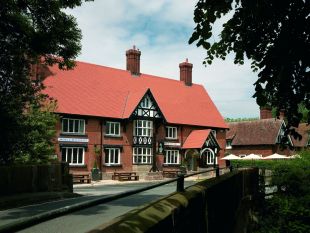Cheshire
Let us help you plan your ideal vacation in Cheshire...
This is an area of contrasts - a very rural part of the county with much of its prosperity founded on agriculture. Traditional industries like salt and leather helped towns like Nantwich and Middlewich develop but it was the industrial revolution that was responsible for changing a small village into the railway town of Crewe.
North Cheshire includes Macclesfield, once famous for its silk industry; Alderley Edge in the "stockbroker belt" has the attractive wooded hillside country of "The Edge"; Wilmslow has some "smart" shops and is close to Manchester Airport and Styal Mill, a National Trust property which is a working museum of the textile industry originally powered by water wheels well worth a visit!. Also included in this area are Knutsford, Northwich, Warrington, Runcorn and Widnes.
South Cheshire, a fairly flat and mainly rural area is rapidly developing as a tourist destination. The two towns making up the Borough of Crewe and Nantwich have distinctly different origins and character. Crewe developed rapidly as a result of the coming of the railways whereas neighbouring Nantwich has many traditional black & white properties dating back centuries.
The City of Chester, established as Deva by the Romans 2,000 years ago on the banks of the River Dee, is the historic gem of North West England. It is easily accessed by motorway and rail, and is the gateway to the castles and coast of North Wales and a good touring base for the great houses and gardens of Cheshire and the Wirral.
Chester is the most complete walled city in Britain. The original walls were built by the Romans, and today they offer a two mile walkway around the city interrupted by historic towers and ancient gates in the form of imposing stone arches.
Another great legacy of Roman times is the Amphitheatre, the largest stone-built arena discovered in Britain, with tiered seating for 7,000 people. The Deva Roman Experience is a vivid introduction to Chester's Roman origins. The Eastgate Clock stands, not surprisingly, above the Eastgate which is crossed by the walkway of the city walls. The present Eastgate was built in 1768-9 and the clock in 1899 for Queen Victoria's Diamond Jubilee.
The Industrial Revolution brought canals, railways and roads to Chester. The Rows and the Cathedral were restored, and the Eastgate Clock was erected to mark Queen Victoria's diamond jubilee. Chester races take place on the Roodee Racecourse on the riverside every month from May to September. Motor racing takes place at the nearby Oulton Park Circuit, and there are several boat races on the River Dee. Chester offers a wide choice of accommodation in an excellent touring location.
In the Middle Ages, Chester was by the far the most important port in northern England. Global trading brought considerable affluence to the city, and during this period the famous half-timbered double-decker Rows were built. These distinctive promenades line the four roads radiating from the Cross - they are unique to Chester with evocative names such as Broken Shin Row and Pepper Alley.
Chester Cathedral towers above the city: originally a 10th Century church dedicated to St. Werburgh, a Mercian princess, it is the site of a wealthy Norman Benedictine Monastery and only became a cathedral after the dissolution of the Monasteries by Henry VIII.
Chester is well served by museums and galleries: Chester Castle is the site of the Military Museum, and nearby is the Grosvenor Museum with the Roman Stones Gallery and diorama of the Roman fortress as it was about AD220.
Read More






















